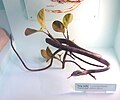Superregnum: Eukaryota
Regnum: Animalia
Subregnum: Eumetazoa
Cladus: Bilateria
Cladus: Nephrozoa
Superphylum: Deuterostomia
Phylum: Chordata
Cladus: Craniata
Subphylum: Vertebrata
Infraphylum: Gnathostomata
Superclassis: Tetrapoda
Cladus: Reptiliomorpha
Cladus: Amniota
Classis: Reptilia
Cladus: Eureptilia
Cladus: Romeriida
Subclassis: Diapsida
Cladus: Sauria
Infraclassis: Lepidosauromorpha
Superordo: Lepidosauria
Ordo: Squamata
Subordo: Serpentes
Infraordo: Caenophidia
Superfamilia: Colubroidea
Familia: Colubridae
Subfamilia: Colubrinae
Genus: Thelotornis
Species: T. capensis – T. kirtlandii – T. usambaricus
Name
Thelotornis (Laurenti, 1768)
Vernacular names
English: Twig Snakes
The twig snakes (genus Thelotornis), also commonly known as bird snakes or vine snakes, are a genus of rear-fanged venomous snakes in the family Colubridae. The genus is native to Africa. All species in the genus have a slender and elongated profile, a long tail, a narrow head, and a pointed snout. The eye of all species has a horizontal pupil, shaped like a keyhole, which gives twig snakes binocular vision. Twig snakes are greyish-brown with faint light and dark markings. When threatened, they inflate the throat to display bold black markings between the scales. Twig snakes are deadly: the venom is hemotoxic, affecting the blood clotting mechanism and causing uncontrolled bleeding and internal hemorrhaging.[2] Bites by twig snakes have caused death in humans; famous herpetologist Robert Mertens died after being bitten by his pet Savanna vine snake (Thelotornis capensis). However, envenomed bites are extremely rare when not handling the snake, as the fangs can't reach the skin except in a few places like the web between the thumb and fingers.
Species
The genus Thelotornis contains four species which are recognized as being valid.[3]
| Image | Scientific name | Common name | Distribution |
|---|---|---|---|
 |
Thelotornis capensis A. Smith, 1849 | Savanna vine snake | southern Africa. |
 |
Thelotornis kirtlandii (Hallowell, 1844) | Forest vine snake | Angola, Benin, Cameroon, Central African Republic, Congo, DR Congo, Equatorial Guinea, Gabon, Ghana, Guinea, Guinea-Bissau, Ivory Coast, Kenya, Liberia, Nigeria, Sierra Leone, Somalia, Tanzania, Togo, Uganda, and Zambia. |
 |
Thelotornis mossambicanus (Bocage, 1895) | Eastern vine snake | Eastern Africa. |
| Thelotornis usambaricus Broadley, 2001 | Usambara vine snake | Tanzania (East Usambara Mts), Kenya (coast), Mozambique |
Nota bene: A binomial authority in parentheses indicates that the species was originally described in a genus other than Thelotornis.
Anatomy and behaviour
Twig snakes are among the few rear-fanged colubrids whose bite is highly venomous and potentially fatal.[4] The venom is hemotoxic, and although its effects are very slow, and bites are rare, no antivenom has been developed and several fatalities (such as Robert Mertens) have occurred. They prey on birds, lizards and frogs, and conceal themselves in trees, though often at a low enough level to be able to also strike at terrestrial prey, which they may swallow upwards after killing. Their cryptic coloration and apparent ability to freeze or sway gently, as chameleons do, like a twig on a tree (hence the name), makes them hard to spot. Indeed, they may be more abundant in areas than is immediately obvious.
Description
The African twig snakes are distinctive in appearance and unlikely on that continent to be mistaken for any other snake, if indeed the observer notices them. Thelotornis is characterised by a depressed and flat head, keyhole-shaped pupils, and in T. kirtlandii, a projecting canthus rostralis which forms a shallow loreal groove on each side of the head, which allows some binocular vision. In appearance, the head at least is unlikely to be mistaken for any other African snake. Other characteristics include a very long tail and large back fangs. The iris in T. capensis and T. kirtlandii is yellow, and presumably therefore also in T. usambaricus.
Etymology
The specific name, kirtlandii, is in honor of American naturalist Jared Potter Kirtland.[5]
References
"Thelotornis ". Dahms Tierleben. www.dahmstierleben.de/systematik/Reptilien/Squamata/Serpentes/colubroidea/colubridae/colubrinae.
"Twig snake". African Snakebite Institute. Retrieved 23 June 2018.
"Thelotornis ". The Reptile Database. www.reptile-database.org.
Goin, Coleman J.; Goin, Olive B.; Zug, George R. (1978). Introduction to Herpetology, Third Edition. San Francisco: W.H. Freeman. xi + 387 pp. ISBN 0-7167-0020-4. ("Thelotornis kirtlandi [sic]", p. 322).
Beolens, Bo; Watkins, Michael; Grayson, Michael (2011). The Eponym Dictionary of Reptiles. Baltimore: Johns Hopkins University Press. xiii + 296 pp. ISBN 978-1-4214-0135-5. ("Thelotornis kirtlandi [sic]", p. 142).
Further reading
Boulenger GA (1896). Catalogue of the Snakes in the British Museum (Natural History). Volume III., Containing the Colubridæ (Opisthoglyphæ and Proteroglyphæ) ... London: Trustees of the British Museum (Natural History). (Taylor and Francis, printers). xiv + 727 pp. + Plates I-XXV. (Genus Thelotornis, pp. 184–185).
Branch, Bill (2004). Field Guide to Snakes and other Reptiles of Southern Africa. Sanibel Island, Florida: Ralph Curtis Books. 399 pp. ISBN 0-88359-042-5. (Genus Thelotornis, p. 100).
Smith A (1849). Illustrations of the Zoology of South Africa, Reptilia. London: Smith, Elder, and Co. (Thelotornis, new genus).
Retrieved from "http://en.wikipedia.org/"
All text is available under the terms of the GNU Free Documentation License

